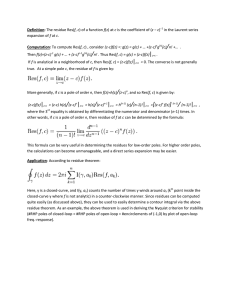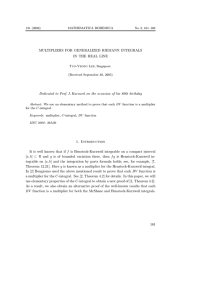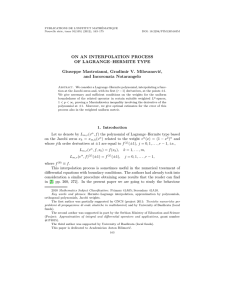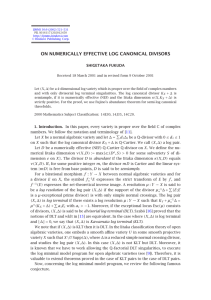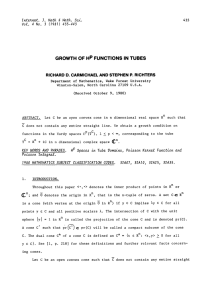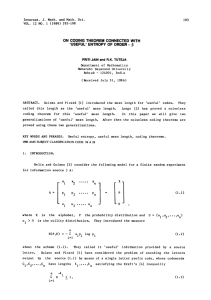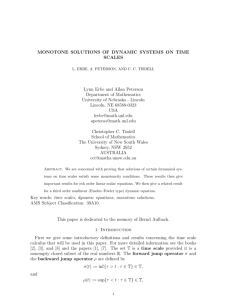Residue calculus (1996) PDF
advertisement
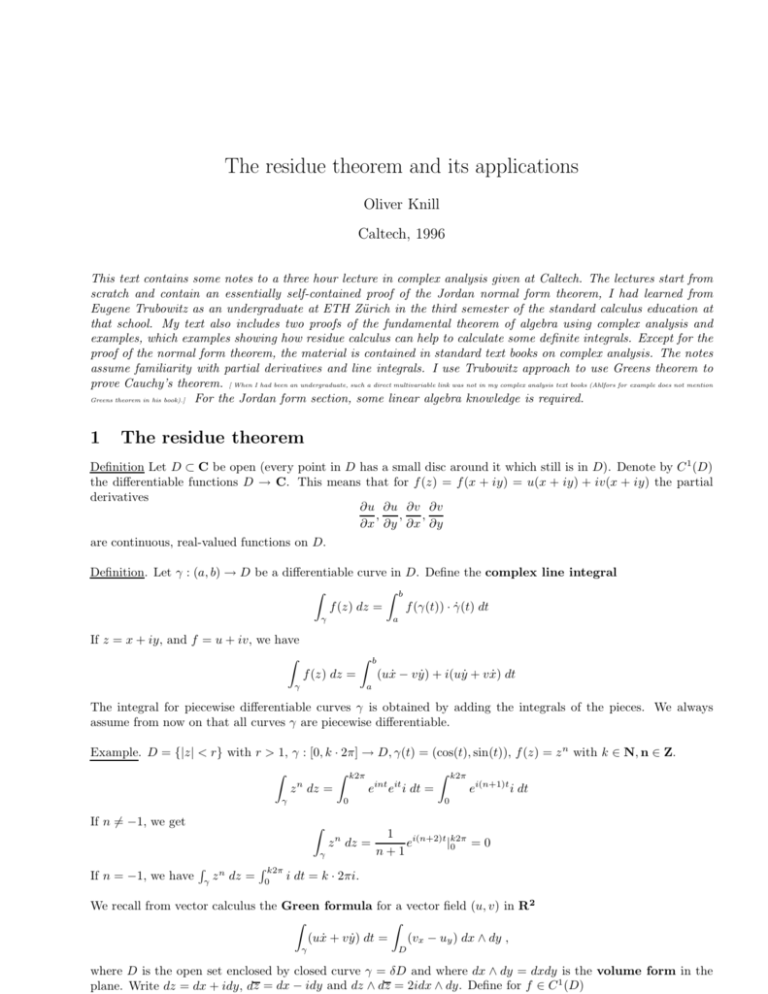
The residue theorem and its applications
Oliver Knill
Caltech, 1996
This text contains some notes to a three hour lecture in complex analysis given at Caltech. The lectures start from
scratch and contain an essentially self-contained proof of the Jordan normal form theorem, I had learned from
Eugene Trubowitz as an undergraduate at ETH Zürich in the third semester of the standard calculus education at
that school. My text also includes two proofs of the fundamental theorem of algebra using complex analysis and
examples, which examples showing how residue calculus can help to calculate some definite integrals. Except for the
proof of the normal form theorem, the material is contained in standard text books on complex analysis. The notes
assume familiarity with partial derivatives and line integrals. I use Trubowitz approach to use Greens theorem to
prove Cauchy’s theorem. [ When I had been an undergraduate, such a direct multivariable link was not in my complex analysis text books (Ahlfors for example does not mention
Greens theorem in his book).] For the Jordan form section, some linear algebra knowledge is required.
1
The residue theorem
Definition Let D ⊂ C be open (every point in D has a small disc around it which still is in D). Denote by C 1 (D)
the differentiable functions D → C. This means that for f (z) = f (x + iy) = u(x + iy) + iv(x + iy) the partial
derivatives
∂u ∂u ∂v ∂v
,
,
,
∂x ∂y ∂x ∂y
are continuous, real-valued functions on D.
Definition. Let γ : (a, b) → D be a differentiable curve in D. Define the complex line integral
Z
Z b
f (z) dz =
f (γ(t)) · γ̇(t) dt
γ
If z = x + iy, and f = u + iv, we have
Z
a
f (z) dz =
γ
b
Z
a
(uẋ − v ẏ) + i(uẏ + v ẋ) dt
The integral for piecewise differentiable curves γ is obtained by adding the integrals of the pieces. We always
assume from now on that all curves γ are piecewise differentiable.
Example. D = {|z| < r} with r > 1, γ : [0, k · 2π] → D, γ(t) = (cos(t), sin(t)), f (z) = z n with k ∈ N, n ∈ Z.
Z
z n dz =
γ
Z
k2π
0
If n 6= −1, we get
Z
z n dz =
γ
If n = −1, we have
R
γ
z n dz =
R k2π
0
eint eit i dt =
Z
k2π
ei(n+1)t i dt
0
1 i(n+2)t k2π
e
|0 = 0
n+1
i dt = k · 2πi.
We recall from vector calculus the Green formula for a vector field (u, v) in R2
Z
Z
(uẋ + v ẏ) dt =
(vx − uy ) dx ∧ dy ,
γ
D
where D is the open set enclosed by closed curve γ = δD and where dx ∧ dy = dxdy is the volume form in the
plane. Write dz = dx + idy, dz = dx − idy and dz ∧ dz = 2idx ∧ dy. Define for f ∈ C 1 (D)
Theorem 1.1 (Complex Green Formula)
f ∈ C 1 (D), D ⊂ C, γ = δD.
Z
Z
f (z)dz =
D
γ
∂f
dz ∧ dz .
∂z
Proof. Green’s theorem applied twice (to the real part with the vector field (u, −v) and to the imaginary part with
the vector field (v, u)) shows that
Z b
Z
f (z) dz =
(uẋ − v ẏ) + i · (uẏ + v ẋ) dt
γ
a
coincides with
Z
D
∂f
dz ∧ dz
∂z
i
1
(ux − vy ) + (uy + vx ) 2idx ∧ dy
2
2
Z
ZD
(ux − vy )dx ∧ dy
(−uy − vx )dx ∧ dy + i ·
Z
=
=
D
D
We check that
∂u
∂v ∂v
∂u
∂f
=0 ⇔
=
,
=−
.
∂z
∂x
∂y ∂x
∂y
The right hand side are called the Cauchy-Riemann differential equations.
Definition. Denote by C ω (D) the set of functions in C 1 (D) for which
are called analytic or holomorphic in D.
∂f
∂z
= 0 for all z ∈ D. Functions f ∈ C ω (D)
Corollary 1.2 (Theorem of Cauchy)
f ∈ C ω (D), D ⊂ C, γ = δD.
Z
f (z) dz = 0 .
γ
Proof.
Z
γ
f (z) dz =
Z
D
∂f
dz ∧ dz = 0
∂z
Corollary 1.3 (Cauchy’s Integral formula)
f ∈ C (D), D simply connected, γ = δD. For any a ∈ D
Z
1
f (w) dw
f (a) =
.
2πi γ w − a
ω
Proof. Define for small enough ǫ > 0 the set Dǫ = D \ {|z − a| ≤ ǫ} and the curve γǫ : t 7→ z + ǫeit . (Because D is
open, the set Dǫ is contained in D for small enough ǫ). Because γ ∪ −γǫ = δDǫ we get by Cauchy’s theorem 1.2
Z
Z
f (w)
f (w)
dw −
dw = 0 .
γǫ w − a
γ w−a
We compute
Z
γǫ
f (w)
dw =
w−a
Z
0
2π
f (z + ǫ · eit ) d
(a + ǫeit ) dt = i ·
a + ǫ · eit − a dt
Z
2π
0
The right hand side converges for ǫ → 0 to 2πif (a) because f ∈ C 1 (D) implies
|f (a + ǫeit ) − f (a)| ≤ C · ǫ
f (a + ǫ · eit ) dt
Corollary 1.4 (Generalized Cauchy Integral formulas)
Assume f ∈ C ω (D) and D ⊂ C simply connected, and δD = γ. For all n ∈ N
one has f (n) (z) ∈ C ω (D) and for any z ∈
/γ
Z
f (w) dz
n!
.
f (n) (z) =
2πi γ (w − z)n+1
Proof. Just differentiate Cauchy’s integral formula n times.
It follows that f ∈ C ω (D) is arbitrary often differentiable.
Definition Let f ∈ C ω (D \ {a}) and a ∈ D with simply connected D ⊂ C with boundary γ. Define the residue of
f at a as
Z
1
Res(f, a) :=
f (z) dz .
2πi γ
By Cauchy’s theorem, the value does not depend on D.
Example. f (z) = (z − a)−1 and D = {|z − a| < 1}. Our calculation in the example at the beginning of the section
gives Res(f, a) = 1.
A generalization of Cauchy’s theorem is the following residue theorem:
ω
f ∈ C (D \
Corollary 1.5 (The residue theorem)
D open containing {zi } with boundary δD = γ.
{zi }ni=1 ),
1
2πi
Z
f (z) dz =
γ
n
X
Res(f, zi ) .
i=1
Proof. Take ǫ soSsmall that Di = {|z − zi | ≤ ǫ} are all disjoint and contained in D. Applying Cauchy’s theorem to
the domain D \ n1=1 Di leads to the above formula.
2
Calculation of definite integrals
The residue theorem has applications in functional analysis, linear algebra, analytic number theory, quantum field
theory, algebraic geometry, Abelian integrals or dynamical systems.
In this section we want to see how the residue theorem can be used to computing definite real integrals.
The first example is the integral-sine
Z
Si(x) =
0
x
sin(t)
dt ,
t
a function which has applications in electrical engineering. It is used also in the proof of the prime number
theorem which states that the function π(n) = {p ≤ n | p prime} satisfies π(n) ∼ x/log(x) for x → ∞.
Si(∞) =
Z
0
iz
∞
π
sin(x)
dx =
x
2
Proof. Let f (z) = ez which satisfies f ∈ C ω (C \ {0}). For z = x ∈ R, we have Im(f (z)) =
S4
R > ǫ > 0 the open set D enclosed by the curve γ = i=1 γi , where
sin(x)
x .
Define for
Figure 1
γ1 : t ∈ [ǫ, R] 7→ t + 0 · i.
γ2 : t ∈ [0, π] 7→ R · eit .
γ3 : t ∈ [−R, −ǫ] 7→ t + 0 · i.
γ4 : t ∈ [π, 0] 7→ ǫ · eit .
R
-R
By Cauchy’s theorem
Z
Z
f (z) dz =
0=
γ
R
eix
dx +
x
ǫ
π
Z
0
it
eiRe
iReit dt +
Reit
Z
ǫ
−R
eix
dx +
x
Z
0
π
it
eiǫe
iǫeit dt .
ǫeit
The imaginary part of the first and the third integral converge for ǫ → 0, R → ∞ both to Si(∞). The imaginary
part of the fourth integral converges to −π because
Z π
it
lim
eiǫe i dt → iπ .
ǫ→0
0
it
The second integral converges to zero for R → ∞ because |eiRe | = |e−R sin(t) | ≤ |e−Rt | for t ∈ (0, π/2].
Z
∞
−∞
1
dx = π
1 + x2
Proof. Take f (z) = 1 + z 2 which has a simple pole a = i in the upper half plane. Define for R > 0 the half-disc D
S
with a hole which has as a boundary the curve γ = 2i=1 γi with
γ1 : t ∈ [−R, R] 7→ t + 0 · i.
γ2 : t ∈ [0, π] 7→ R · eit .
f is analytic in D \ {i} and by the residue theorem
Z π
Z R
Z
iReit dt
1
dx
=
= 2πi · Res(f (z), i) = 2πi · lim (z − i) · f (z) = π
f (z) dz =
2
2
2it
z→i
0 1+R ·e
γ
−R 1 + x
The second integral from the curve γ2 goes to zero for R → ∞.
Let f, g be two polynomials with n = deg(g) ≥ 2 + deg(f )
such that the poles zi of h := f /g are not on R+ ∪ {0}.
Z
0
∞
h(x) dx = −
n
X
i=1
Res(h(z) · log(z), zi )
Proof. Define for R > r > 0 the domain D enclosed by the curves γR ∪ γ− ∪ γr ∪ γ+ with γ+ : t ∈ [r, R] 7→ t + 0 · i.
γ− : t ∈ [R, r] 7→ t + 0 · i.
γR : t ∈ [0, 2π] 7→ R · eit .
γr : t ∈ [0, 2π] 7→ r · e−it .
and apply the residue theorem for the function h(z) · log(z):
Z
Z
Z
Z
Z
h(z) log(z) dz
h(z) log(z) dz +
h(z) log(z) dz +
h(z) log(z) dz +
h(z) log(z) dz =
R
Because of the degree assumption, γR h(z) log(z) → 0 for R → ∞. Because h is analytic near 0 and log(z) goes
R
slower to ∞ than z → 0 we get also γr h(z) log(z) dz → 0 as r → 0. The sum of the last two integrals goes to
R∞
−(2πi) 0 h(x) dx because
Z
Z
γ+
h(z) log(z) dz = −
Z
π
0
π
dθ
,a > 1
dθ = √
a + cos(θ)
a2 − 1
Proof. Put z = eiθ . Then
a + cos(θ) = a +
Let γ : θ 7→ eiθ
Z
0
π
1
dθ
dθ =
a + cos(θ)
2
√
h(z)(log(z) + 2πi) dz .
γ−
Z
0
2π
2az + z 2 + 1
z + z −1
=
.
2
2z
dθ
dθ =
a + cos(θ)
Z
γ
2dz
1
.
2i 2az + z 2 + 1
From the two zeros −a ± a2 − 1 of the polynomial 2az + z 2 + 1 the root λ+ is in the unit disc and λ− outside
the unit disc. From the residue theorem, the integral is
π
1
2π
1
=√
, λ+ ) =
.
2πi Res(
i
2az + z 2 + 1
λ+ − λ−
a2 − 1
3
Jordan normal form for matrices
As an other application of complex analysis, we give an elegant proof of Jordan’s normal form theorem in
linear algebra with the help of the Cauchy-residue calculus.
Let M (n, R) denote the set of real n × n matrices and by M (n, C) the set n × n matrices with complex entries.
For A ∈ M (n, C) the characteristic polynomial is
det(λ − A) =
k
Y
(λ − λi )µi .
i=1
We simply write λ − A instead of λI − A, where I is the identity
Pkmatrix. The complex numbers λi are called the
eigenvalues of A and µi denote their multiplicities. Clearly i=1 µi = n.
Two matrices A, B ∈ M (n, C) are called similar if there exists an invertible matrix S such that A = S −1 BS.
A
Theorem 3.1 (Jordan normal form
[A1 ]
0
0
[A
2]
∈ M (n, C) is similar to a matrix
...
...
0
0
λi 1
· 1
are called normal blocks.
·
λi 1
λi
theorem)
...
0
...
0
0
where Ai =
...
[Ak ]
Remark. It follows if all eigenvalues of A are different, then A is diagonalizable.
Denote for λ 6= λi the resolvent matrix
R(λ) = (λ − A)−1 .
The function λ 7→ R(λ) is analytic in D = C \ {λi } in the sense that for all i, j, the functions λ 7→ [R(λ)]ij are
(where A(ij) are the matrices obtained by deleting the i’ th row and the j ′ th column of A), such that
[R(λ)]ij =
αij (λ)
.
det(λ − A)
Lemma 3.2 (The resolvent identity)
R(λ) − R(λ′ ) = (λ′ − λ)R(λ)R(λ′ )
Proof. From A(λ − A) = (λ − A)A follows R(λ)A = AR(λ) and we get by filling in (λ′ − A)R(λ′ ) = I and
(λ − A)R(λ) = I
R(λ) − R(λ′ ) = R(λ)(λ′ − A)R(λ′ ) − (λ − A)R(λ)R(λ′ ) = (λ′ − λ)R(λ)R(λ′ ) .
Definition C ω (D, M (n, C)) denotes the set of functions f : D 7→ M (n,
R C), such that for all i, j the map z 7→ [f (z)]ij
is in C ω (D). Given a curve γ in D we define the complex integral f (z) dz by
Z
Z
[ f (z) dz]ij = [f (z)]ij dz .
Define for δ < minij |λi − λj | and γi : t 7→ zi + δeit the matrices
Z
1
Pi =
R(λ) dλ
2πi γi
Z
1
(λ − λi )R(λ) dλ .
Ni =
2πi γi
1)
2)
3)
4)
5)
Theorem 3.3 (Jordan decomposition of a matrix)
Pi Pj = δij Pj ,
Pk
i=1 Pi = I.
Ni Pj = δij Ni = Pj Ni
Ni Nj = 0, i 6= j, Pi (A − λi ) = Ni , Niµi = 0
Pk
Pk
A = i=1 λi Pi + i=1 Ni
Proof.
1) For i 6= j we have using the resolvent identity
Z Z
Z
Z
R(λ′ ) dλ′ =
R(λ) dλ
(2πi)2 Pi Pj =
γj
γi
γi
R(λ)R(λ′ ) dλdλ′
γj
R(λ) − R(λ′ )
dλ dλ′
λ′ − λ
γi γj
Z
Z
Z
Z
1
1
′
′
R(λ)
=
R(λ
)
dλ
dλ
+
dλ dλ′ = 0 .
′−λ
′−λ
λ
λ
γj
γi
γj
γi
=
Z Z
On the other hand, with γi′ : t 7→ λi + δ/2 · eit
Z Z
Z Z
R(λ) − R(λ′ )
R(λ) − R(λ′ )
2
′
(2πi) Pi Pi =
dλ dλ =
dλ dλ′
′
′ −λ
′
λ
−
λ
λ
γi γi
γi γi
Z
Z
Z
Z
1
1
′
′
dλ dλ −
dλ dλ′
R(λ )
R(λ)
=
′
′
′
′
γi
γi λ − λ
γi λ − λ
γi
Z
= 2πi ·
R(λ′ )dλ′ ,
γi′
where we used
1
γi′ λ′ −λ
R
dλ′ = 0 and
1
γi λ′ −λ
R
dλ = 2πi.
2) Using Cauchy’s theorem we have for any curve γR = {|λ| = R} enclosing all the eigenvalues
Z
k Z
k
X
1 X
1
Pi =
R(λ) dλ =
R(λ) dλ
2πi i=1 γi
2πi γR
i=1
Z
Z
1
A
1
A
=
R(λ) dλ
R(λ) − R(λ) dλ +
The claim follows from
1
2πi
and from the fact that for R → ∞
Z
γR
−1
since |R(λ)ij | ≤ C · λ
Z
γR
1
dλ = 1
λ
A
R(λ) dλ → 0
λ
for a constant C only dependent on A.
3) For i 6= j, we get with the resolvent identity
Z Z
(2πi)2 Ni Pj =
(λ − λi ) · R(λ)R(λ′ ) dλ dλ′
γi
γj
=
Z Z
=
Z Z
γi
γi
γj
γj
λ − λi
(R(λ) − R(λ′ )) dλ dλ′
λ′ − λ
Z Z
λ − λi
λ − λi
′
R(λ) dλ dλ −
R(λ′ ) dλ dλ′ = 0 .
′
′
λ −λ
γi γj λ − λ
Using the curve γi′ = {|λ − λi | = δ/2} we have
Z Z
2
(2πi) Ni Pi =
(λ − λi ) · R(λ)R(λ′ ) dλ dλ′
γi
=
γi′
λ − λi
(R(λ) − R(λ′ )) dλ dλ′
λ′ − λ
γi
Z
Z
Z
Z
1
1
′
′
(λ
−
λ
)R(λ
)
dλ
dλ
+
dλ′
(λ − λi )R(λ) dλ
i
′
′
γi′ λ − λ
γi
γi′ λ − λ
γi
Z Z
γi′
=
=
(2πi)2 Ni .
4) Ni Nj = 0 is left as an exercise. (The calculation goes completely analogue to the already done calculations in
1) or in 3)
Z
Z
R(λ)(A − λi ) − I dλ
R(λ)(A − λi ) dλ =
(2πi)Pi (A − λi ) =
γi
γ
Z i
R(λ)(A − λi ) − R(λ)(A − λ) dλ
=
γ
Z i
(λ − λi )R(λ) dλ = (2πi)Ni .
=
γi
Using 3) and 1) we get from the just obtained equality
Z
R(λ)(A − λi )k dλ
(2πi)Nik = (2πi)Pi (A − λi )k =
γi
Z
k
R(λ)(A − λi ) − R(λ)(A − λi )k−1 (A − λ) dλ
=
γ
Z i
R(λ)(A − λi )k−1 (λ − λi ) dλ
=
γ
Z i
R(λ)(A − λi )(k−1) (λ − λi ) − R(λ)(A − λi )k−2 (A − λ) dλ
=
γ
Z i
R(λ)(A − λi )k−2 (λ − λi )2 dλ .
=
γi
Repeating like this k − 2 more times, we get
(2πi)Nik
=
Z
γi
(λ − λi )k R(λ) dλ .
The claim Niµi follows from the fact that (λ − λi )µi R(λ) is analytic.
Remark. It follows that the matrix A leaves invariant the subspaces Hi = Pi H of H = Cn and acts on Hi as
v 7→ λi v + Ni v .
There is a basis of Hi , the matrices Ni have 1 in the side diagonal and are 0 everywhere else: by 4), we know that µi
is the smallest k such that Nik = 0. It implies that all eigenvalues of N are 0. There exists a vector v ∈ Hi such that
P
n−1
{Nik v = vk }k=0
form a basis in Hi . (This is an exercise: any nontrivial relation j aj Nij v = 0 would imply that Ni
0 1
· 1
.
·
had an eigenvalue different from 0). In that basis, the transformation Ni is the matrix Ni =
0 1
0
The matrix A is now a direct sum of Jordan blocks A = ⊕ki=1 Ai , where
λi 1
· 1
.
·
Ai =
λi 1
λi
Exercises: 1) Perform the calculation which had been left out in the above proof: show that
Ni Nj = 0, i 6= j .
2) Show that if a linear transformation N on a µ dimensional space has the property N µ = 0 and N k 6= 0 for
k < µ, then there is a basis in which N is a Jordan block with zeros in the diagonal.
4
The argument principle
Cauchy’s integral formula and the residue formula can be expressed more naturally using the notion of the winding
number.
Lemma 4.1
Let γ be closed curve in C avoiding a point a ∈ C. There exists k ∈ Z such
that
Z
dz
= 2πik .
γ z−a
Proof. Define
h(t) :=
Since h′ (t) = z ′ (t)/(z(t) − a), we get
Z
t
0
z ′ (s) ds
.
z(s) − a
d −h(t)
e
(z(t) − a) = h′ (t)e−h(t) (z(t) − a) + e−h(t) z ′ (t) = 0 .
dt
and e−h(t) (z(t) − a) = e−h(0) (z(0) − a) is a constant. Therefore eh(t) =
which means h(2π) = 2πik.
z(t)−a
z(0)−a
and especially eh(2π) =
z(2π)−a
z(0)−a
=1
Definition The index or winding number of a closed curve γ with respect to a point a ∈
/ γ is
Z
1
dz
n(γ, a) =
∈ 2πiZ .
2πi γ z − a
The definition is legitimated by the above lemma.
Cauchy’s integral formula and the residue theorem holds more generally for any closed curve γ in a simply con-
If f ∈ C ω (D)
n(γ, z) · f (z) =
Z
γ
1 f (w) dw
.
2πi w − z
If f ∈ C ω (D \ {zi }ni=1 )
1
2πi
Z
f (z) dz =
γ
n
X
n(γ, zi ) Res(f, zi ) .
i=1
Theorem 4.2 (Argument principle for analytic functions)
Given f ∈ C ω (D) with D simply connected. Let ai be the zeros of f in D and
γ a curve in D avoiding ai . Then
Z ′
X
1
f (z)
dz
n(γ, ai ) =
2πi
γ f (z)
i
Proof. Write
f (z) = (z − a1 )(z − a2 ) . . . (z − an )g(z)
where g(z) has no zeros in D. We compute
1
1
g ′ (z)
1
f ′ (z)
+
+ ...
+
=
.
f (z)
z − a1
z − a2
z − an
g(z)
Cauchy’s theorem gives
Z
γ
g ′ (z)
dz = 0
g(z)
and the formula follows from the definition of the winding number.
Definition If f ∈ C ω (D \ {z}) for a neighborhood D of a, then a is called an isolated singularity of f . If there
exists n ∈ N such that
lim (z − a)n+1 · f (z) = 0
n→∞
then a is called a pole of f . The smallest n such that the above limit is zero is called the order of the pole. If an
isolated singularity is not a pole, it is called an essential singularity. If f ∈ C ω (D \ {zi }) and each zi is a pole
then f is called meromorphic in D.
Theorem 4.3 (Argument principle for meromorphic functions)
Let f be meromorphic in the simply connected set D, ai the zeros of f , bi the
poles of f in D and γ a closed curve avoiding ai , bi .
n
X
i
n(γ, ai ) −
k
X
j
n(γ, bj ) =
1
2πi
Z
γ
f ′ (z)
dz
f (z)
Proof. The function
g(z) := f (z) · (z − b1 ) . . . (z − b2 ) . . . (z − bk )
is analytic in D and has the zeros ai . Write
Z
Z ′
1
1
1
1
f ′ (z)
g (z)
1
+
... +
) dz =
+
dz
(
2πi γ f (z)
z − b1
z − b2
z − bk
2πi γ g(z)
P
The right hand side is by argument principle for analytic maps equal to i n(γ, ai ). The left hand side is
Z ′
X
1
f (z)
n(γ, bj ) .
dz +
2πi γ f (z)
Theorem 4.4 (Generalized argument principle)
Let f be meromorphic in the simply connected set D, ai the zeros of f , bi the
poles of f in D and γ a closed curve avoiding ai , bi and g ∈ C ω (D).
n
X
i
g(ai )n(γ, ai ) −
k
X
g(bi )n(γ, bj ) =
j
Proof. Write again
Qn
f (z) = h(z) Qki=1
1
2πi
Z
γ
g(z) ·
f ′ (z)
dz
f (z)
(z − ai )
j=1 (z
− bj )
with analytic h which is nowhere zero and so
n
g(z) ·
k
X g(bj )
h′ (z)
f ′ (z) X g(ai )
−
+ g(z)
=
.
f (z)
z − ai j=1 z − bj
h(z)
i=1
As an application, take h ∈ C ω (∆) with ∆ = {|z − a| < r} and D = h(∆). For z ∈ ∆ put ξ = h(z). The function
f (w) = h(w) − ξ has only one zero in D. Apply the last theorem with g(w) = w. We get
Z
wh′ (w)
1
−1
dw
h (ξ) = z =
2πi δ(D) h(w) − ξ
which is a formula for the inverse of h.
Assume f ∈ C ω (D \ {zi }) is meromorphic. Denote by Zf = Zf (D) the number of zeros of a function in D and
with Pf = Pf (D) the number of poles of f in D.
Theorem 4.5 (Rouché’s theorem)
Given meromorphic f, g ∈ C ω (D \ {zi }). Assume for DR = {z | |z − a| < R} ⊂
D, γ = δDR
|f (z) − g(z)| < |g(z)|, z ∈ γ .
Then
Zf − Pf = Zg − Pg .
Proof. The assumption implies that
|
f (z)
− 1| < 1, z ∈ γ
g(z)
and h := f /g maps therefore γ into the right half plane. We can define log(f /g) by requiring that
Im(log(h(z))) = arg(h(z)) ∈ (−π/2, π/2) .
The function log(h(z)) is a primitive of h′ /h =
0=
1
2πi
Z
γ
(f /g)′
f /g .
We have so
1
(f /g)′
dz =
f /g
2πi
Z
γ
g′
f′
−
dz .
f
g
Apply the argument principle.
Rouché’s theorem leads to an other proof of the fundamental theorem of algebra:
Theorem 4.6 (Fundamental theorem of algebra)
Every polynomial f (z) = p(z) = z n + a1 z n−1 + . . . + an has exactly n roots.
Proof.
p(z)
zn
= 1 + a1 /z + . . . an /z n goes to 1 for |z| → ∞. Consider the function g(z) = z n and D = {|z| < R}.
